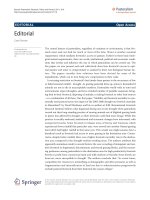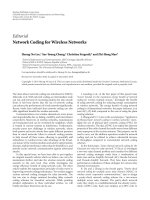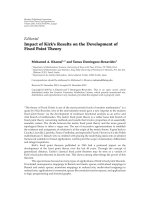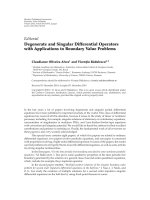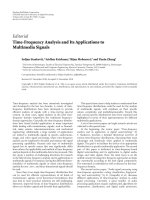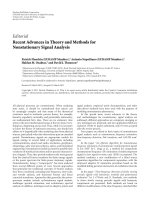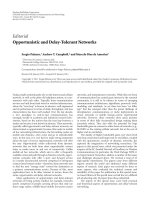Báo cáo hóa học: " Editorial Reconfigurable Computing and Hardware/Software Codesign" potx
Bạn đang xem bản rút gọn của tài liệu. Xem và tải ngay bản đầy đủ của tài liệu tại đây (420.4 KB, 2 trang )
Hindawi Publishing Corporation
EURASIP Journal on Embedded Systems
Volume 2008, Article ID 731830, 2 pages
doi:10.1155/2008/731830
Editorial
Reconfigurable Computing and Hardware/Software Codesign
Toomas P. Plaks,
1
Marco D. Santambrogio,
2
and Donatella Sciuto
2
1
University of Reading, Berkshire RG6 6AH, UK
2
Politecnico di Milano, 20133 Milano, Italy
Correspondence should be addressed to Toomas P. Plaks,
Received 23 December 2007; Accepted 23 December 2007
Copyright © 2008 Toomas P. Plaks et al. This is an open access article distributed under the Creative Commons Attribution
License, which permits unrestricted use, distribution, and reproduction in any medium, provided the original work is properly
cited.
Modern consumer appliances as wireless communication
and multimedia systems present very strong requirements
for the digital parts of these systems: digital design pro-
cess must provide solutions which possess high performance,
flexibility for multifunctional use, and energy efficiency.
Over the past decade, the reconfigurable computing platform
has been an emerging approach in scientific research and in
practical implementations to meet these requirements.
The special issue on “Reconfigurable Computing and
Hardware/Software Codesign” addresses the advances in re-
configurable computing architectures, in algorithm imple-
mentation methods, and in automatic mapping methods of
algorithms onto hardware and processor spaces, indicating
the changes in codesign flow due to the introduction of new,
reconfigurable hardware platform. Using this platform, the
designer faces a new paradigm of computing and program-
ming: the computing system is capable of run-time and au-
tonomous modification of its functionalities following the
changing needs of applications.
This new scenario of hardware/software codesign pro-
vides a great improvement in the embedded system design
and implementation. To cope effectively and timely with the
new challenges, the new and more sophisticated dynamic
reconfiguration strategies together with codesign methods
have to be developed.
In the first paper, “Design flow instantiation for run-time
reconfigurable systems: a case study,” Y. Qu et al. present
a design flow instantiation for run-time reconfigurable sys-
tems using a real-life application—part of a WCDMA de-
coder. The design flow is roughly divided into two parts:
system level and implementation. At system level, hard-
ware resource estimation and performance evaluation are ap-
plied. At implementation level, technology-dependent tools
are used to realize the run-time reconfiguration. The results
show that run-time reconfiguration can save 50% of the area
when compared to a functionally equivalent fixed system and
achieves 30 times speedup in processing time when com-
pared to a functionally equivalent pure software design.
In “A flexible system level design methodology targeting
run-time reconfigurable FPGAs,” F. Berthelot et al. present
an automatic design generation methodology for heteroge-
neous architectures. This method automatically generates
designs for fixed and partially reconfigurable parts of an
FPGA and enables a reconfiguration prefetching technique to
minimize reconfiguration latency and buffer-merging tech-
niques to minimize memory requirements of the generated
design. This concept has been applied to different wireless ac-
cess schemes, based on a combination of OFDM and CDMA
techniques.
The next paper, “RRES: a novel approach to the parti-
tioning problem for a typical subset of system,” by G. B. Kn-
err et al., integrates some of the most powerful approaches
for system partitioning into a consistent design framework
for wireless embedded systems, which has led to the devel-
opment of an entirely new approach for the system parti-
tioning problem. The paper introduces the restricted range
exhaustive search algorithm and compares this to popular
and well-reputed heuristic techniques based on tabu search,
genetic algorithm, and the global criticality/local phase al-
gorithm. This search algorithm proves superior performance
for a set of system gr a phs featuring specific properties found
in human-made task graphs, since it exploits their typical
characteristics such as locality, sparsity, and their degree of
parallelism.
The paper “Software-controlled dynamically swappable
hardware design in partially reconfigurable systems,” by C.
Huang and H. Pao-Ann, considers different wrapper de-
signs for hardware designs such that they can be enhanced
2 EURASIP Journal on Embedded Systems
with the capability for dynamic swapping controlled by soft-
ware. A hardware design with proposed wrappers can be
swapped out of the partially reconfigurable logic at run-time
in some intermediate state of computation and then swapped
in when required to continue from that state. With the ca-
pability for dynamic swapping, high-priority hardware tasks
can interrupt low-priority tasks in real-time embedded sys-
tems so that the utilization of hardware space per unit time
is increased.
In “DART: a functional-level reconfigurable architec-
ture for high energy efficiency,” S. Pillement et al. deal
with functional-level reconfiguration to improve energy ef-
ficiency. The paper presents the DART architecture, which
supports two modes of reconfiguration: fine-grained and
functional level, to achieve the optimized solutions. The
compilation framework is built using compilation and high-
level synthesis techniques. As a proof of the concept, a 3G
mobile communication application has been implemented
and the VLSI design of a 0.13 µm CMOS SoC implementing
a specialized DART cluster is presented.
The last paper of this issue “Exploiting process local-
ity of reference in RTL simulation acceleration,” by A. D.
Blumer and C. D. Patterson, addresses the simulation accel-
eration of digital designs. An analysis of six register transfer
level (RTL) code bases shows that only a subset of the sim-
ulation processes is executing at any given time. Run-time
adaptations are made to ensure that acceleration resources
are not wasted on idle processes, and these adaptations may
be effected through process migration between software and
hardware. Finally, the paper describes an implementation of
an embedded, FPGA-based migration system; the empirical
data are obtained for use in mathematical and algorithmic
modelling of more complex acceleration systems.
Toomas P. Plaks
Marco D. Santambrogio
Donatella Sciuto

